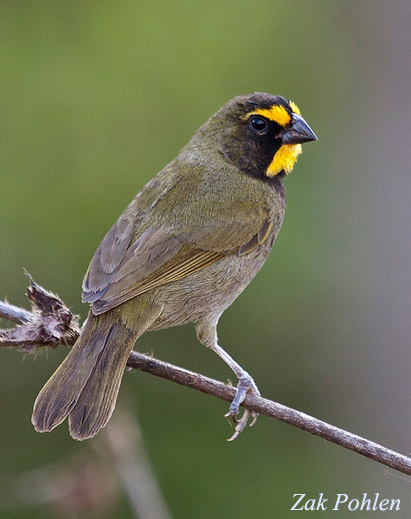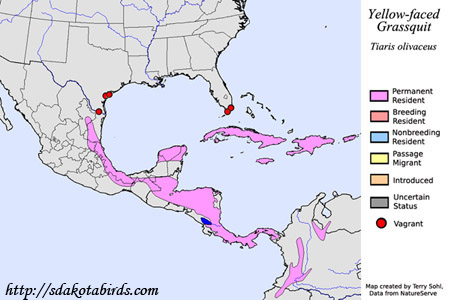| Length: 4.25 inches | Wingspan: 6.5 inches | Seasonality: Non-resident in South Dakota |
| ID Keys: Yellow eyebrows and throat unique, olive-gray overall, lighter underneath | ||
 The
Yellow-faced Grassquit is a rare vagrant to the United States, being found
on several occasions in extreme southern Texas along the Rio Grande, or in
extreme southern Florida. The normal range covers much of eastern Mexico,
Central America, and scattered locations in far northern South America.
They are also an introduced species in Hawaii, where they have established
likely permanent breeding populations.
The
Yellow-faced Grassquit is a rare vagrant to the United States, being found
on several occasions in extreme southern Texas along the Rio Grande, or in
extreme southern Florida. The normal range covers much of eastern Mexico,
Central America, and scattered locations in far northern South America.
They are also an introduced species in Hawaii, where they have established
likely permanent breeding populations.
Habitat: Found in a variety of settings with scattered trees and shrubs, including fencelines, roadside thickets, shrubby or grassy fields, and forest clearings. They typically need some taller and thicker vegetation such as scattered shrubs, and they will avoid areas of unbroken grassland or pasture.
Diet: Feeds almost exclusively on seeds if available, preferring the seeds of a few select species, but taken others if those are not available. They will also occaisionally take fruits and berries, and insects and spiders. Nectar is also taken from flowers.
Behavior: Foraging is usually done by hopping on the ground, scratching the ground as it moves along. Insects are gleaned from the ground or from vegetation.
Nesting: Yellow-faced Grassquits are loosely colonial when nesting, with several nests in one small area. The nest itself is a domed cup of small sticks, lined with grasses, animal hair, or other softer items. The female lays between 2 and 4 eggs, and she alone incubates them. Incubation takes about two weeks, after which, both parents tend to the young and feed them.
Song: Song is a buzzy, quiet trilling.
Migration: Considered a permanent resident throughout most of its range. Given records in the United States, there are some indications of movement for some birds after breeding.
Feeders: Will attend feeders for commonly offered seed items.
Interactive eBird map: Click here to access an interactive eBird map of Yellow-faced Grassquit sightings
Similar Species: Distinctive if seen well.
Conservation Status: Populations of the Yellow-faced Grassquit appear to be increasing, and the species is found across a wide geographic range. The IUCN lists the Yellow-faced Grassquit as a species of "Least Concern".
Further Information: 1) Cornell's NeoTropical Birds - Yellow-faced Grassquit
2) BirdLife International - Yellow-faced Grassquit
3) WhatBird - Yellow-faced Grassquit
Photo Information: Photo by Zak Pohlen - January 29th, 2013 - Costa Rica - Photo licensed under Creative Commons Attribution NonCommercial NoDerivs 2.0 Generic License
| Click below for a higher-resolution map |
 |
| South Dakota Status: Non-resident in South Dakota |
Additional Yellow-faced Grassquit Photos (coming soon!!)
